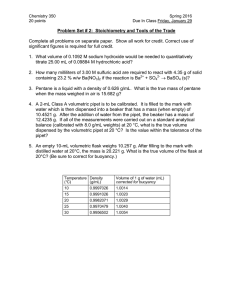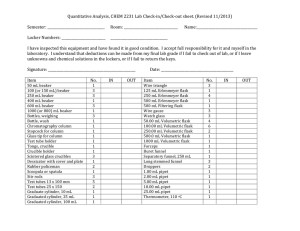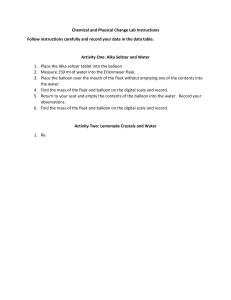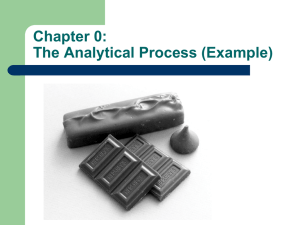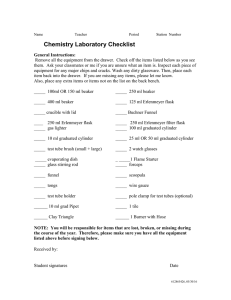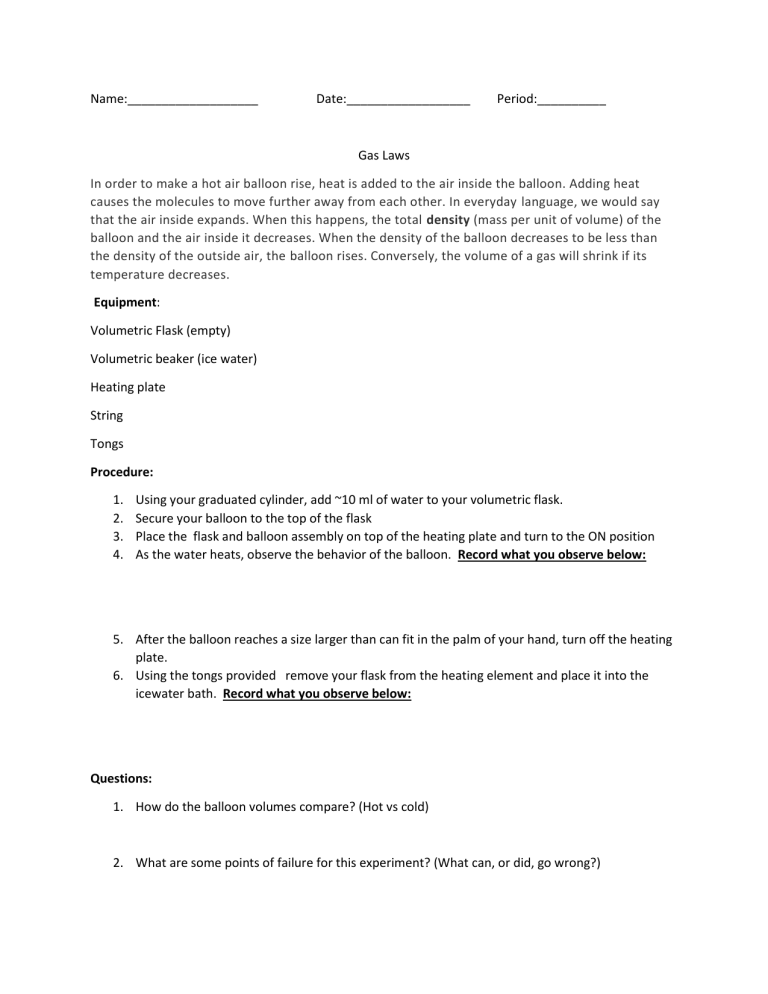
Name:___________________ Date:__________________ Period:__________ Gas Laws In order to make a hot air balloon rise, heat is added to the air inside the balloon. Adding heat causes the molecules to move further away from each other. In everyday language, we would say that the air inside expands. When this happens, the total density (mass per unit of volume) of the balloon and the air inside it decreases. When the density of the balloon decreases to be less than the density of the outside air, the balloon rises. Conversely, the volume of a gas will shrink if its temperature decreases. Equipment: Volumetric Flask (empty) Volumetric beaker (ice water) Heating plate String Tongs Procedure: 1. 2. 3. 4. Using your graduated cylinder, add ~10 ml of water to your volumetric flask. Secure your balloon to the top of the flask Place the flask and balloon assembly on top of the heating plate and turn to the ON position As the water heats, observe the behavior of the balloon. Record what you observe below: 5. After the balloon reaches a size larger than can fit in the palm of your hand, turn off the heating plate. 6. Using the tongs provided remove your flask from the heating element and place it into the icewater bath. Record what you observe below: Questions: 1. How do the balloon volumes compare? (Hot vs cold) 2. What are some points of failure for this experiment? (What can, or did, go wrong?) Activity #2 To determine the relationship between the volume and the temperature of a gas and to estimate the value of absolute zero. Safety 1. Wear protective goggles throughout the laboratory activity. 2. Whenever a heating plate is used, care should be taken to avoid burns. 3. Do not leave thermometer in beaker between measurements. Procedure 1. Completely fill an empty pipet with water. 2. Count the number of drops it takes to empty the pipet. (Repeat for better accuracy using a new pipet.) 3. Record the average number of drops. This number represents the volume of the pipet. It also represents the volume of gas at the higher temperature in this activity. ______________ 4. There will be a room-temperature aquarium full of water. You will use this to submerge your pipettes after warming. 5. Mostly fill the beaker with water. Heat until the water is about 20 °C above room temperature. 6. Holding a new pipet by the stem, immerse its bulb in the warm water in the beaker. Hold in the water for 1 min to allow the temperature of the air in the pipet become equal to that of the water. 7. Pinch the end of the pipet stem with pliers or a fingernail to seal it off. Record the temperature of the warm water in the beaker. 8. Fully submerge the pipet in the tank containing room-temperature water. When submerging, try to hold the pipet horizontally. Make sure that the stem is under the water and unseal. What happens in the stem of the pipet? Keep the pipet submerged until no further changes are noted (about 1 min). 9. Remove the pipet from the water and dry the outside. Count the number of drops of water that were drawn into the pipet. This number, subtracted from the original number, represents the volume of the air sample at the lower temperature. 10. Increase the temperature of the water bath by 10 °C and repeat the procedure using a new, dry pipet. 11. Repeat Steps 8-10 until a temperature of about 90 °C is reached. Temp. °C Volume at higher Temp. (in drops) (Volume of empty pipet) Volume at lower Temp. (in drops) Room Temp. 1 2 3 4 Data Analysis Prepare a graph of your data, with temperature (in degrees Celsius) on the horizontal axis (x axis) and total air volume in the bulb (in drops) at that temperature on the vertical axis (y axis). Decide on a “best” estimate for absolute zero, based on your overall graph results. Название оси Drops Vs Temp 0 Название оси Implications and Applications 1. What is the relationship between the volume and the Celsius temperature as shown on your graph? 2. Absolute zero theoretically measures the limit of molecular motion. What is the volume of an ideal gas sample at absolute zero? Activity #3 Corn is a common foodstuff, native to the Americas, which appears in many forms: corn on the cob, corn off the cob, creamed corn, and popcorn. Field corn, which is also fed to livestock, is hung on our doors at Halloween. Each variety of corn contains different amounts of water, sugars, and starches. Popcorn is a favorite as an evening snack. Popping popcorn involves heating the corn until the pressure inside the kernel is great enough to cause it to burst, turning the kernel inside out and releasing the trapped moisture. Purpose: To determine the percent water in popcorn, to use the ideal gas law to determine the pressure inside the kernel when it pops, and to solve gas law problems. Safety 1. Wear protective goggles throughout the laboratory activity. 2. Heat the flask evenly to prevent spattering the oil. 3. Heat with care. Oil is flammable. 4. Do not eat the popcorn. Procedure 1. Record the mass of a weighing cup. 2. Add a few kernels of popcorn and reweigh. 3. Calculate the mass of the popcorn kernels. ____________ 4. Using the water displacement method, find the volume of the kernels using a 10-mL graduated cylinder. Dry the kernels. 5. Add two medicine droppers of cooking oil and the 16 kernels to an empty, dry 125-mL Erlenmeyer flask. 6. Determine the mass of the flask, oil, and popcorn. 7. Place the flask on the heating element, cover with metal mesh, and turn it to a medium heat. 8. Make sure to use the tongs to move the flask periodically. We do not want the popcorn to burn. 12. Let the flask cool, then remove and determine the mass of the beaker and contents. (Remove the copper gauze before weighing.) 13. Thoroughly wash your hands before leaving the laboratory. Help with Your Calculations Please show all work here: *Percent of water in “popcorn” = (Mass of water lost x 100)/(Mass of 16 kernels) ** To estimate the pressure of the water vapor at the time of “pop,” use PV = nRT. Here are some hints regarding this calculation: Step 1. Rearrange the equation to solve for P. Step 2. Use the “moles of water lost” from the data table. Step 3. R = 0.0821 L atm/(mol K) Step 4. Assume that the popcorn pops at the boiling point of the cooking oil (225 °C) and convert this temperature to Kelvins. Step 5. Pressure will be in atm. Implications and Applications 1. What was the percent water in your popcorn? 2. What is the pressure of the water (as a gas) inside the popcorn just as it pops? 3. What was the atmospheric pressure in the laboratory during this activity? 4. Compare the pressure required to “pop” corn (Question 2) with atmospheric pressure (Question 3). 5. What assumptions have you made that might cause errors in your calculation of pressure?
